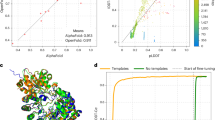Abstract
THE text-book treatment of linear curves of best fit purports to give the best estimate of the relation w1 = pv1 between variables of true value w1, v1, from a set of measured values, w, v. It is applicable when only one parameter is subject to errors of measurement. Thus, when only the values of w are subject to error, the best estimate is given by the curve which minimizes the sum of squares of deviation of w, that is, the regression line of w on v ; and for errors in v only, the regression line of v on w should be taken.
This is a preview of subscription content, access via your institution
Access options
Subscribe to this journal
Receive 51 print issues and online access
$199.00 per year
only $3.90 per issue
Buy this article
- Purchase on Springer Link
- Instant access to full article PDF
Prices may be subject to local taxes which are calculated during checkout
Similar content being viewed by others
References
Seares, F. H., Astrophys. J., 100, 255 (1944).
Author information
Authors and Affiliations
Rights and permissions
About this article
Cite this article
AUSTEN, A., PELZER, H. Linear 'Curves of Best Fit'. Nature 157, 693–694 (1946). https://doi.org/10.1038/157693b0
Issue Date:
DOI: https://doi.org/10.1038/157693b0
Comments
By submitting a comment you agree to abide by our Terms and Community Guidelines. If you find something abusive or that does not comply with our terms or guidelines please flag it as inappropriate.



